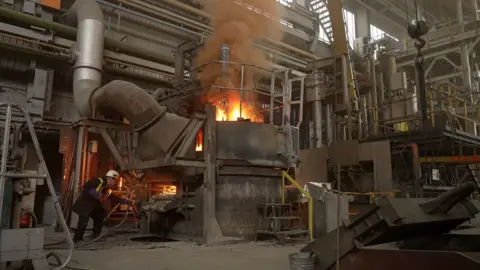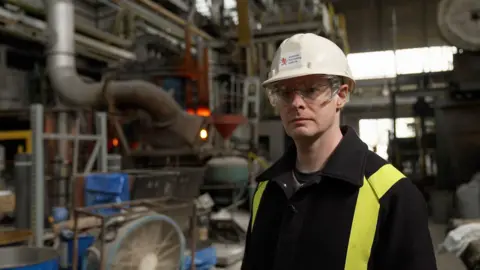
Justin Rowlatt,BBC climate editor , @BBCJustinR
 Getty Images
Getty ImagesScientists say they’ve found a way to recycle cement from demolished concrete buildings.
Cement is the modern world’s most common construction material, but it is also a huge source of planet-warming gas emissions.
That is because of the chemical reactions when you heat limestone to high temperatures by burning fossil fuels.
Recycling cement would massively reduce its carbon footprint. Researchers say that if they switched to electric-powered furnaces, and used renewable energy like wind and solar rather than fossil fuels, that could mean no greenhouse gases would be released at all.
And that would be a big deal. Cement forms the foundation of the modern economy, both literally and metaphorically.
It is what binds the sand and aggregate in concrete together, and concrete is the most widely used material on the planet after water.
It is also a major driver of climate change. If cement was a country, it would be the third biggest source of emissions after China and the US, responsible for 7.5% of human-made CO2.
The problem is the material’s uniquely polluting chemistry.
It is made by heating limestone to up 1600 Celsius in giant kilns powered by fossil fuels.
Those emissions are just the start. The heat is used to drive carbon dioxide from the limestone, leaving a residue of cement.
Add both these sources of pollution together and it is estimated that about a tonne of carbon dioxide is produced for every tonne of cement.
The team of scientists, from Cambridge University, has found a neat way to sidestep those emissions.
It exploits the fact that you can reactivate used cement by exposing it to high temperatures again.
The chemistry is well-established, and it has been done at scale in cement kilns.
The breakthrough is to prove it can be done by piggybacking on the heat generated by another heavy industry – steel recycling.
When you recycle steel, you add chemicals that float on the surface of the molten metal to prevent it reacting with the air and creating impurities. This is known as slag.
The Cambridge team spotted the composition of used cement is almost exactly the same as the slag used in electric arc furnaces.

They have been trialling the process at a small-scale electric arc furnace at the Materials Processing Institute in Middlesbrough.
The BBC was present when the first high grade, or “Portland”, cement was produced.
They are calling it “electric cement” and described the event as a world first.
The lead scientist, Cyrille Dunant, told the BBC it could enable the production of zero-carbon cement.
“We have shown the high temperatures in the furnace reactivate the old cement and because electric arc furnaces use electricity they can be powered by renewable power, so the entire cement making process is decarbonised.,” he said.
He said it also makes steel recycling less polluting because making the chemicals currently used as slag has a high carbon cost too.

Mark Miodownik, Professor of Materials and Society at University College London, described the way the Cambridge team have combined cement and steel recycling as “genius” and believes, if it can be made to work profitably at scale, it could lead to huge reductions in emissions.
“Can it compete against the existing infrastructure that is very unsustainably going to keep pumping cement into our lives”, he asks.
“Cement is already a billion-dollar industry. It’s David and Goliath we are talking about here.”
The hope is electric cement will be cheaper to manufacture because it uses what is essentially waste heat from the steel recycling process.
Spanish company Celsa will attempt to replicate the process in its full-scale electric arc furnace in Cardiff this week.
The Cambridge team estimate, given current rates of steel recycling, their low carbon cement could produce as much as a quarter of UK demand.
But the use of electric arc furnaces is expected to increase in the future, potentially allowing more “electric cement” to be produced.
And, of course, the process could be duplicated all over the world, potentially cutting the emissions from cement dramatically.

